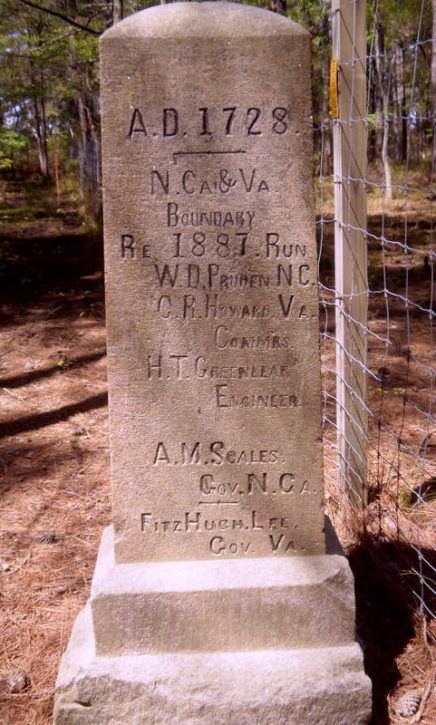The Secret Life of Boundary Markers
At the northernmost point of Carova, against the fence that marks the southern boundary of Back Bay National Wildlife Refuge, there is a concrete obelisk with a date of 1728 along with a list of names.

The marker is the first survey point of a 1728 expedition to fix the border of Virginia and North Carolina. The expedition remains notable because it established an accurate and agreed upon border. It is also notable because of the writings of William Byrd, the Virginia Commissioner who was placed in charge of the expedition.
Byrd actually wrote two accounts of the expedition, neither of which was published in his lifetime. The History of the Dividing Line Betwixt Virginia and North Carolina is factual and somewhat dry; The Secret History of the Line Betwixt Virginia gives the true story and was published posthumously.
A little bit of background:
There was quite a bit of tension about exactly where to delineate the border between the two states. A 1710 attempt was largely conceded to have been incomplete and incompetently done. Virginians felt landowners on the border were failing to pay taxes on products and property that were owed to the state. On the North Carolina side, the belief was that Virginia was unfairly claiming land that was not theirs.
The dispute had become so heated that British King George I—this was colonial times—stepped in and ordered the two states to undertake a surveying mission.
William Bryd was politically connected in Virginia and well-qualified to lead the expedition. Because of his Virginia connection, he viewed his North Carolina team members (and the state in general) with considerable disdain.
His feeling about North Carolina only appear in his Secret History, but they make for a very interesting read.
About the North Carolinian diet he writes, “ The Truth of it is, these People live so much upon Swine’s flesh, that it don’t only incline them to the Yaws, & consequently to the downfall of their Noses, but makes them likewise extremely hoggish in their Temper, & many of them seem to Grunt rather than Speak in their ordinary conversation.”
He assigned pseudonyms to all the characters of his Secret History. Byrd assigned himself the sobriquet Steddy—and throughout the writings, it’s Steddy who seems to be the calming, logical influence.
At 24, Samuel Swann, the youngest member of the expedition, was assigned the name Bootes. The surveyor for North Carolina, Bryd expressed reservations about his qualifications when he showed up with the rest of the North Carolina delegation.
“These worthy Gentlemen were attended by Bootes, as their Surveyor, a Young Man of much Industry, but no Experience.”
Already tense, the expedition got off to a rocky start when the North Carolina commissioners were late meeting their Virginian counterparts.
“Shoebrush & Puzzlecause made a Shift to come to Us, after calling at every House, where they expected any Refreshment; after the necessary Complements, & a Thousand Excuses for making us wait for them so long…”
Puzzlecause, in real life the North Carolina Attorney General William Little, comes in for particularly biting commentary.
“Puzzlecause had degenerated from a New-England Preacher for which his Godly Parents design’d him, to a very wicked, but awkward rake.”
Despite the squabbling and daunting and dangerous terrain, the survey parties were able to accomplish the mission. They pushed through the Dismal Swamp—even today considered a dangerous morass, and stopped in the spring of the year after 73 miles. In autumn they resumed their survey, laying out another 100 miles of border.
The work the commission did was remarkably accurate for its day. There have been adjustments over the years to the original borders, but for the most part they have been minor.
